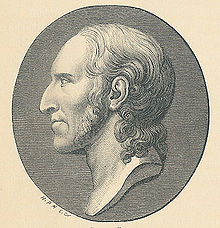Georg Zoëga

Georg (Jørgen) Zoëga (20 December 1755 – 10 February 1809) was a Danish scientist. He was noted for his work as an
Biography
Jørgen (Georg) Zoëga was born at Daler parish in Tønder Municipality in Southern Jutland. His father Vilhad Christian Zoëga (1721-1790), whose family came originally from Northern Italy, was the parish priest at Møgeltønder Church (Møgeltønder kirke); his mother Henriette Emilie Ottosdatter Clausen (ca 1735-1763) was daughter of the superintendent of Schackenborg Castle (Schackenborg Slot). His brother was botanist Johan Zoëga (1742-1788). [2][3] [4]
As a boy Jørgen was taught at home and then attended the gymnasium in Altona. He went in 1773 to the University of Göttingen and later to Leipzig, studying philosophy and the Classics. Repeated journeys to Italy developed an interest in archaeology, which had awakened early in him. In 1782, thanks to the Danish minister Ove Høegh-Guldberg (1731–1808), he received for two years a pension from the State. From Vienna, where he studied under the celebrated numismatist Joseph Hilarius Eckhel (1737–1798), Zoëga went to

On his way home in 1784, Zoëga heard in
From 1798, Zoëga was Danish
Zoega is regarded as an associate of German art historian and archaeologist Johann Joachim Winckelmann (1717–1768) and Italian antiquarian Ennio Quirino Visconti (1751–1818) in establishing the basis for archaeological science. His services to learning were also acknowledged in foreign countries by his election in 1806 to membership in the Academies of Science at Berlin and Vienna. He died in Rome three years later.[10] [11]
Selected works
- Nummi aegyptii imperatorii (Rome, 1787)
- De origine et usu obeliscorum (Rome, 1797)
- Bassorilievi antichi di Roma (2 vols., Rome, 1808), translated into German by Friedrich Gottlieb Welcker (1811)
- Catalogus codicum copticorum manuscriptorum, qui in museo Borgiano Velitris adservantu (Rome, 1810), a posthumous work.
He also wrote several treatises on classical archaeology, also translated into German by Welcker, Georg Zoegas Abhandlungen (Göttingen, 1817). A work on the topography of Rome was left unfinished in manuscript.
See also
References
- ^ "Zoega, Georg (Jørgen), 1755-1809". Dansk biografisk Lexikon. Retrieved January 1, 2020.
- ^ "Zoega, Johan, 1742-88". Dansk biografisk Lexikon. Retrieved January 1, 2020.
- ^ "Møgeltønder kirke". nordenskirker.dk. Retrieved January 1, 2020.
- ^ "Schackenborg Slot". kongehuset.dk. Retrieved January 1, 2020.
- ^ "Ove Høegh-Guldberg". Nordisk familjebok. Retrieved January 1, 2020.
- ^ "Joseph Hilarius Eckhel". gedaechtnisdeslandes.at. Retrieved January 1, 2020.
- ^ "Stefano Borgia (1731-1804)". BnF Services. Retrieved January 1, 2020.
- ^ Alin Suciu. "The Borgian Coptic Manuscripts in Naples" (PDF). suciualin.files. Retrieved January 1, 2020.
- ^ "Sacy (Antoine Isaac, baron Silvestre de)". cosmovisions.com. Retrieved January 1, 2020.
- ^ "Johann Joachim Winckelmann (1717-1768)". arthistoricum.net. Retrieved January 1, 2020.
- ^ "Viscónti, Ennio Quirino". Treccani. Retrieved January 1, 2020.
Oher sources
- Karen Ascani, Paola Buzi, Daniela Picchi (2015) The Forgotten Scholar: Georg Zoëga (1755-1809) (Brill) ISBN 978-90-04-29023-5
Further reading
- Daniela Williams, Bernhard Woytek "Zoëga studente di numismatica. Il soggiorno a Vienna (1782) e i contatti con Joseph Eckhel", in K. Ascani, P. Buzi, D. Picchi (eds) The Forgotten Scholar: Georg Zoëga (1755-1809). At the Dawn of Egyptology and Coptic Studies, Leiden - Boston 2015, pp. 101–110.
- Øjvind Andreasen (ed.), Georg Zoëga - Briefe und Dokumente, vol. I, Det Danske Sprog- og Litteraturselskab, Copenhagen, 1967. ISBN 87-7876-426-2.
- Øjvind Andreasen og Karen Ascani (eds.), Georg Zoëga - Briefe und Dokumente, vol. II-V, Det Danske Sprog- og Litteraturselskab, 2013. ISBN 978-87-7533-023-2.
![]() This article incorporates text from a publication now in the public domain: Herbermann, Charles, ed. (1913). "Jörgen Zoega". Catholic Encyclopedia. New York: Robert Appleton Company.
This article incorporates text from a publication now in the public domain: Herbermann, Charles, ed. (1913). "Jörgen Zoega". Catholic Encyclopedia. New York: Robert Appleton Company.
